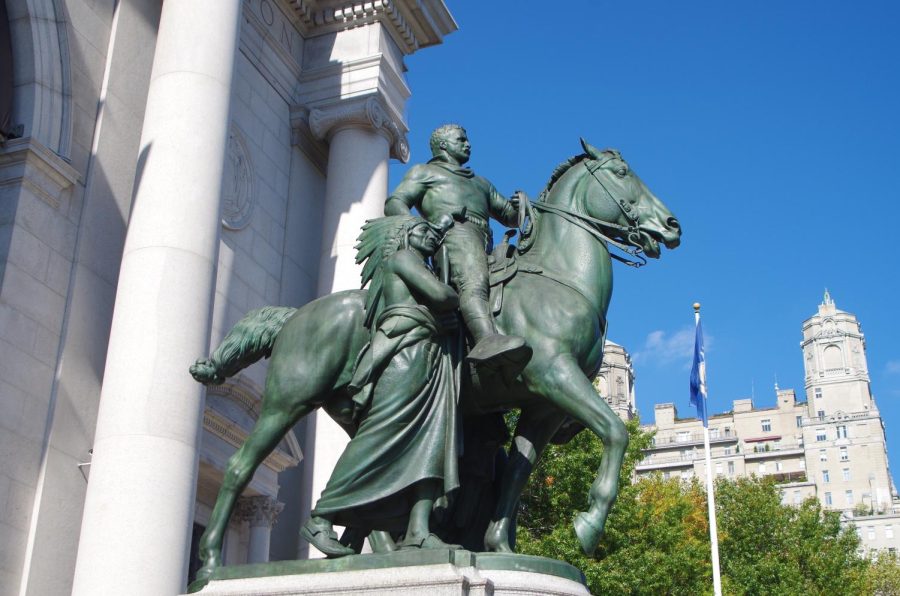Removal of Theodore Roosevelt statue is a step toward accountability
February 18, 2022
After being associated with racist imagery for many years, a statue of former President Theodore Roosevelt that stood in front of the American Museum of Natural History was rightfully removed.
In recent years, the statue has come to symbolize the country’s painful legacy of colonial expansion and racial discrimination. In light of nationwide conversations about racism, the removal of Roosevelt’s statue was the right choice.
The bronze statue, formerly known as the “Equestrian Statue of Theodore Roosevelt” has greeted visitors to the American Museum of Natural History for some 80 years. It depicts the former New York governor on horseback, flanked by an indigenous man and a man of African descent.
Given the recent debates over whether to preserve, contextualize or destroy monuments, it’s even more important to understand the legacy of the individuals honored. For a complex individual like Roosevelt, whose resume includes being a conservationist, police commissioner, soldier and Nobel Peace Prize winner, his modesty may come as a surprise.
Roosevelt strongly opposed plans to memorialize him, going so far as to fight a group that once sought to preserve his birthplace in New York City. Moreover, it was Roosevelt himself that ordered the demolition of his old childhood home, saying he “felt very uncomfortable about the effort” to memorialize him.
Additionally, Roosevelt has long been remembered as an environmentalist, whose administration established over 230 million acres of public lands. As such, it seems fitting that Roosevelt’s memorial sits outside a museum dedicated to the exploration of natural history.
However, the same sculpture makes no mention of his environmental legacy. Instead, the statue elevates Roosevelt’s most controversial qualities.
Thus, the removal of the statue was the right choice because it prevents the glorification of Roosevelt’s worst qualities and combats outdated racial theories that have no place in today’s society.
Subsequently, many critics have pointed to Roosevelt’s documented use of racial stereotypes and his role in the Spanish-American War, as further evidence for the statue’s removal. In recent years, historians have regarded Roosevelt as an imperialist who sought conflict in the Caribbean that ended in American colonization of the region.
Nevertheless, for all the controversy, it’s important to understand the statue symbolizes none of Roosevelt’s achievements. Rather, the decision to remove the monument serves as a lesson for all Americans.
There was a time in history when the statue was accepted and seen as a positive depiction of Roosevelt. This, of course, is a reminder of how racial and discriminatory ideals can be deeply woven into the social fabric of American society.
Furthermore, the existence of this statute highlights the controversy of honoring a public figure like Roosevelt. The former president was not immune to criticism of being a politician, but he was also an individual with his ideas and beliefs. And today, many of his ideas and beliefs are no longer acceptable.
Yet, more than a century after his death, the greatest lesson that Roosevelt gives is how to properly commemorate public figures. It is essential to highlight their contributions to society, not their flaws.
A member of the Roosevelt family also released a statement following the decision to remove the statue.
“The world does not need statues, relics of another age, that reflect neither the values of the person they intend to honor nor the values of equality and justice,” Theodore Roosevelt, a great-grandson of Roosevelt, said. “The composition of the Equestrian Statue does not reflect Theodore Roosevelt’s legacy. It is time to move the statue and move forward.”
The sculpture will be moved to the Theodore Roosevelt Presidential Library in Medora, North Dakota. The site, which will open in 2026, is near the location of a ranch once owned by him.
Overall, the decision to remove the sculpture was the right one, even more so after a long and careful process that sought to address all opinions. Today, the statue’s removal may seem like a controversial act, but in the future, it will be seen as a step forward in addressing America’s racist past.







